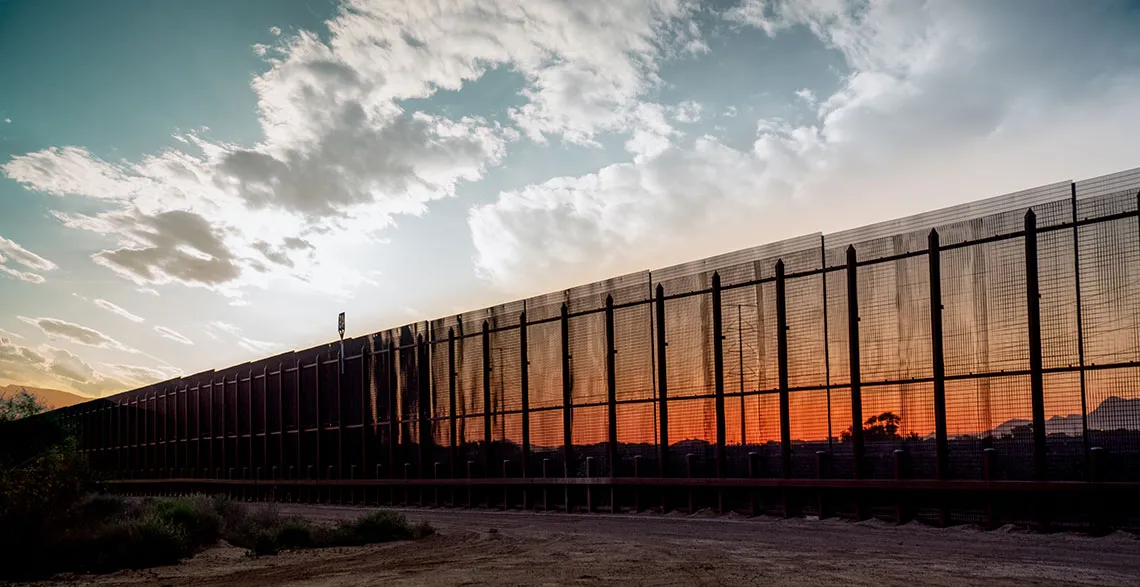The 2,000-mile stretch of land that divides Mexico from the U.S. is rich in native species. But what happens when their range is disrupted? Here’s a look at the impact barrier-creation has had thus far.
The politics of the wall gets most of the attention, but the environmental impact and adverse effects on wildlife on the border are monumental. These major environmental disruptions may permanently alter the landscape, putting a fragile ecosystem at even greater risk.
“Even before the border wall, the border’s biodiversity was already threatened by continued pressure of population growth, urban expansion and climate change,” says Margaret Wilder, Associate Professor, School of Geography and Development and Center for Latin American Studies Environment & Natural Resources 2. “So, the border fence and now the border wall strike another massive blow to this fragile and important ecological system that we live in and love.”
Wilder goes on to describe four key effects of the wall on native species and wildlife: First is what she describes as the “tightening of the noose of pressure the wall contributes to the trifecta of growth/urban sprawl and climate change” that the region is already experiencing. Second are the “direct impacts on species.” Next is the devastating impact on scarce water sources and, lastly, the significant strain on the “long-term cooperation between the U.S. and Mexico on border environment issues,” threatening a nearly century-long partnership on “collaborative solutions to the most vexing water and environmental issues.”
A Wall Runs Through It
The Arizona-Mexico border is 2,000 miles long, and only follows a natural feature when it meets the Rio Grande river in Texas. Up until that point, says Jeffrey Banister, Director, The Southwest Center Associate Research, Social Scientist, Editor, and Research Professor Southwest Center, Journal of the Southwest, and School of Geography and Development, it’s “just a line in the sand.”
“[The wall] is just running right across these landscapes without any connection to them. In fact, it's in stark contrast to them,” he says. “So, you could imagine all the damage that's being done by having all those crews out there; the machinery and what they're blasting; and they’re pumping groundwater. By the time they're done, according to the current plan, almost all of Arizona will have border wall.”
And a tall one, in some places 30 feet high, making it impossible for wildlife to travel beyond it, essentially trapping countless animals. This poses profound problems for the myriad species that exist in these spaces — like those that “need a great distance to subsist and to reproduce,” says Banister. “Like the jaguar, which requires a very broad range to mate and hunt … a lot of native species move across, back and forth across that line in the sand, and their natural range is being greatly truncated.”
According to Wilder, the wall is “a sort of nail in the coffin of an ecological region under pressure, under siege,” she says. “The border wall undermines nearly 100 years of cooperation between the two countries to preserve and share water resources and to protect the environment and species, for the health and benefit of all.
“In one stroke, the wall may deliver a crushing blow to these efforts,” she says, “and the ecology of the region is likely to be damaged and changed forever.”
Wilder goes on to cite the fact that at least 36 environmental laws have been waived to allow the construction of the border fence and wall, including major federal laws like the Endangered Species Act, National Environmental Protection Act and so many more.
But Banister cites organizations — such as the Malpai Borderlands Group, which was founded by ranchers who live and work primarily in Southeast Arizona and Southwest New Mexico — and individual landowners and ranchers who are “fighting good fights,” he says, and challenging the federal government in the courts.
“There are many, many people working for the people and communities and landscapes in Southern Arizona right now,” says Banister, “across the state, really.”
Wilder, however, says it’s up to all of us, now that the votes have been cast, to continue to urge lawmakers to remove the wall.
“The voters of the United States chose to make changes in their elected representatives to restore our longstanding environmental protections of the last 50 years,” she says. “Let’s take down the wall.”


